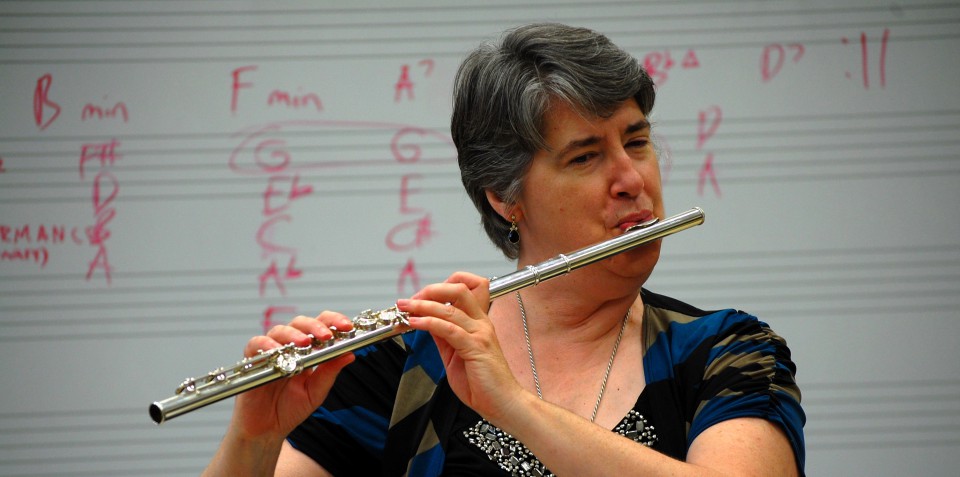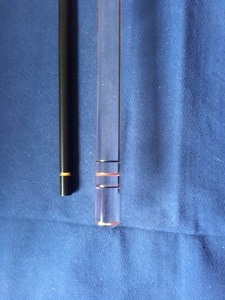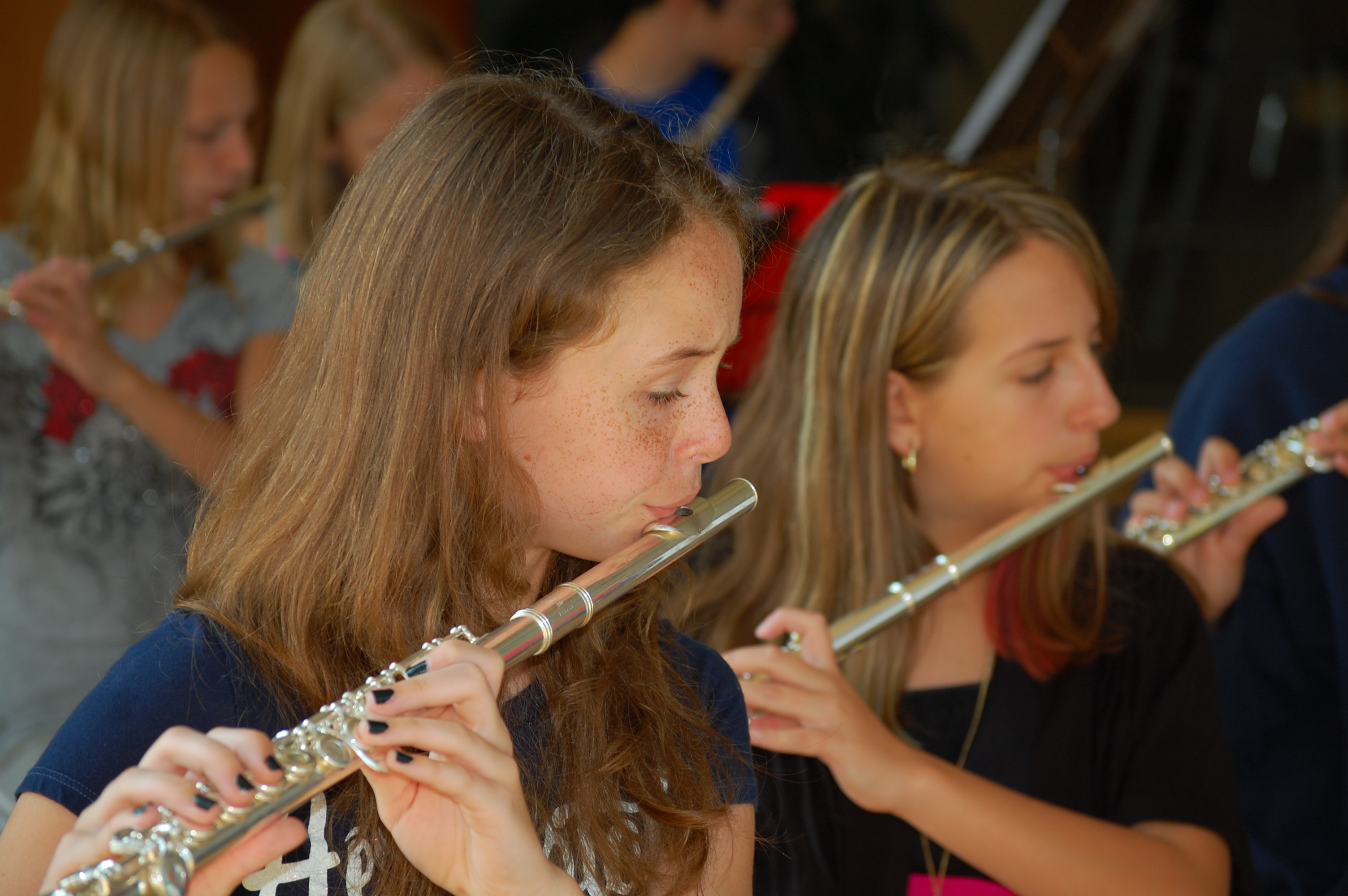Because there are so many variables involved in flute embouchure, there are an infinite number of problems that students can manifest in their tone quality and intonation. And as instructors it might seem we have to virtually be psychic to deduce the problem and offer solutions to our students. This is because so much is affected by things going on in the body that aren’t obvious from looking at a kid. Over the years I’ve been collecting a laundry list, so to speak, of tone/intonation problems and their solutions. Here are some common ones for beginner to intermediate students.
 Problem: Windy, airy tone that is sharp
Problem: Windy, airy tone that is sharp
Solution: The aperture is too large and the blowing angle is too shallow. Blow through a smaller aperture and angle the air down more. You can achieve a steeper blowing angle by putting the flute lower on the bottom lip and reaching over with the top lip more, while maintaining the smaller aperture. The Legend of Kiss and Roll, Independence for Lips!
Problem: Dull tone quality, flat pitch
Solution: There is too much bottom lip covering the blow hole, and the flute is probably too high on the bottom lip. Move the flute lower on the bottom lip and roll out. There shouldn’t be more than 1/3 of the blow hole covered by the bottom lip. Also check alignment of the headjoint and balance of the flute. That alone can cause a student roll in and cover too much of the blow hole. It’s All About Balance
Problem: Strangled or pinched tone, can be flat or sharp depending how high or low the flute is on the bottom lip
Solution: This requires some sleuthing on your part because you have to identify the source of the constriction. There are at least four places I can think of that cause a pinched sound: 1) The lips themselves with a flattened and pinched aperture, 2) clenching the jaw with teeth too close together (common with kids who have braces, especially with rubber bands), 3) the back of the tongue is too high, constricting the airway, and finally, 4) the kid can actually be closing off the throat itself, as in activating the gag reflex. It takes some practice and discernment on your part to tell the difference which of these four constriction points are causing the problem. I can tell you that each one has a distinct quality that identifies it from the others, but it does take carefully listening and practice to recognize each one. Getting the Cart Before the Horse
Problem: Trouble producing third octave notes even with the correct fingerings
Solution: Third octave notes seem scary to kids. To them it seems like the natural thing that in order to control the third octave, they should roll in and pinch. After all, who wants to hear screeching high notes? This is precisely why they are having trouble. The solution, paradoxically, is to open up the blow hole a bit, support the air column more from the body core, and relax the grip of the aperture slightly. The speed of the air column itself will ensure the high note speak with ease. Warm Air, Cold Air
As always, if you find these entries useful, please subscribe, share with your colleagues and come back regularly. Feel free to comment. If you have a topic you would like to see explored more fully, you can contact me via IM/Messenger on Facebook or email me at dr_cate@sbcglobal.net. For information about clinics, workshops and performances, click here.






 Balance the flute in your hands. Turn the headjoint slightly back to align between the key cups and the rods, rather than directly with the key cups. This puts the relatively heavy rods more on top so the flute can rest in your hands. No bracing needed even with all the fingers off the keys (like with C#-Db).
Balance the flute in your hands. Turn the headjoint slightly back to align between the key cups and the rods, rather than directly with the key cups. This puts the relatively heavy rods more on top so the flute can rest in your hands. No bracing needed even with all the fingers off the keys (like with C#-Db). 
 Problem: Windy, airy tone that is sharp
Problem: Windy, airy tone that is sharp We have spent a great deal of virtual ink on this blog exploring flute embouchure, articulation, intonation, technique, dynamics and vibrato. While all of these things are essential to good flute playing, we’re overlooking the elephant in the room, namely blowing. Indeed, if you don’t have good mastery of blowing, you aren’t going to be able to articulate well, play in tune, control dynamics or play with vibrato. All the blah, blah about embouchure is meaningless if you are not moving air through the embouchure into the flute. Technique is worthless without the air behind the fingers.
We have spent a great deal of virtual ink on this blog exploring flute embouchure, articulation, intonation, technique, dynamics and vibrato. While all of these things are essential to good flute playing, we’re overlooking the elephant in the room, namely blowing. Indeed, if you don’t have good mastery of blowing, you aren’t going to be able to articulate well, play in tune, control dynamics or play with vibrato. All the blah, blah about embouchure is meaningless if you are not moving air through the embouchure into the flute. Technique is worthless without the air behind the fingers.
 Of course there is more to getting a characteristic sound than just shaping the aperture. And there are seemingly more variables than specific immutable features to making a good sound. Pretty much the headjoint itself is the only constant. People, their lips, size of their teeth and oral cavity are unique to themselves. Remember to:
Of course there is more to getting a characteristic sound than just shaping the aperture. And there are seemingly more variables than specific immutable features to making a good sound. Pretty much the headjoint itself is the only constant. People, their lips, size of their teeth and oral cavity are unique to themselves. Remember to: